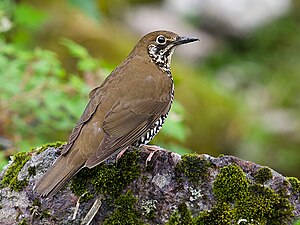Wood thrush
| Wood thrush | ||||||||||||
|---|---|---|---|---|---|---|---|---|---|---|---|---|

Wood Thrush ( Zoothera salimalii ) |
||||||||||||
| Systematics | ||||||||||||
|
||||||||||||
| Scientific name | ||||||||||||
| Zoothera salimalii | ||||||||||||
| Alström et al., 2016 |
The forest thrush ( Zoothera salimalii ) is a songbird species from the thrush family (Turdidae). The art epithet honors the Indian ornithologist Sálim Ali (1896–1987).
features
The wood thrush reaches a body length of 25 to 27 cm. It is similar to the rock thrush ( Zoothera mollissima ), the Sichuan thrush ( Zoothera griseiceps ) and to a lesser extent the Dixon thrush ( Zoothera dixoni ). Compared to the first-mentioned species, the beak is significantly longer and deeper, the ridge of the beak more arched, the hook longer and the edge of the lower beak more arched. The color of the beak is usually completely or nearly dark, including the base of the mandible, while it is usually pale pink in the Dixon's thrush and yellowish in the rock burdock. The beak bristles of the forest thrush are usually longer, thicker, blacker and more protruding than those of the rock thrush. The wings, the wings of the hand, the legs and the tail are shorter, the beak is larger and the hind claw is longer than that of the rock thrush. The nostril fletching is denser, looser and more extensive than that of the Dixon's thrush. The Sichuan thrush appears shorter-billed than the forest thrush due to its large head and overall length, while the forest thrush is more squat due to its very short tail and short legs. The top of the head of the forest thrush is more reddish brown. The chest and underside have a protruding wave pattern like the Sichuan thrush. The neck is slightly lighter than the top of the head. The ear covers are more mottled than those of the Sichuan thrush and have dark and light areas. The reins, the under-eye stripe and the beard stripe are darker and more contrasting than those of the Sichuan thrush. Compared to the Dixon thrush, the wood thrush has a more powerful beak, a shorter tail and barrel, and more monochrome ear covers, wing covers, hand covers and hand-wing edges. The belly and the lower tail-coverts are more strongly marked and less white than in the Dixon's thrush. The dark markings on the flanks are narrower and more sickle-shaped than on the Dixon's thrush. The under tail has more contrasting and smaller white spots.
Systematics
Zoothera salimalii belongs to the species complex of Zoothera mollissima . In 2016 Zoothera griseiceps , formerly a subspecies of Zoothera mollissima , was raised to the status of a species and Zoothera salimalii was described as an independent species.
Distribution area
The forest thrush has a large distribution area of over 20,000 km². It stretches across India, Nepal, China, Myanmar, Bhutan and Vietnam.
habitat
The wood thrush lives in different forms of habitats, including in the Indian state of Arunachal Pradesh old, primary coniferous forests with rhododendrons , deciduous trees, lush undergrowth and herbs at altitudes of 3430 to 3800 m, but rarely up to the tree line at 4200 m. In West Bengal it occurs between 3200 and 3650 m. In parts of the Chinese province of Yunnan it inhabits steep slopes with bamboo and rhododendrons, rock outcrops with isolated conifers from or just above the upper tree line at 3350 to 3500 m, but apparently not below. In other regions in Yunnan it lives in forests dominated by the Delavays fir ( Abies delavayi ) at altitudes up to 3850 m. Outside the breeding season, Zoothera salimalii apparently prefers deciduous forests at altitudes between 1400 and 3200 m. However, there is little detailed data from this period.
hikes
The migratory behavior of the forest thrush has hardly been researched so far. Outside the breeding season (from September to April), migrations from higher to lower zones have been observed. In winter the birds come down to altitudes of 1400 m, in summer they are not to be found below 3200 m.
Reproductive and feeding behavior
Nothing is known about reproductive and feeding behavior. However, it could be similar to that of the rock thrush.
status
The IUCN added this species to the Red List in 2016 in the “ Least Concern” category. It is locally common in the eastern Himalayas and the forest thrush is also widespread in Dulongjiang in the Chinese province of Yunnan. Information on hazards is currently not available.
literature
- Per Alström, Pamela C. Rasmussen, Chao Zhao, Jingzi Xu, Shashank Dalvi, Tianlong Cai, Yuyan Guan, Ruiying Zhang, MV Kalyakin, Fumin Lei & Urban Olsson: Integrative taxonomy of the Plain-backed Thrush (Zoothera mollissima) complex (Aves , Turdidae) reveals cryptic species, including a new species. Avian Research 7 (1), 2016: 1-39. doi : 10.1186 / s40657-016-0037-2 .
- Kirwan, GM (2016). Himalayan Forest Thrush (Zoothera salimalii). In: del Hoyo, J., Elliott, A., Sargatal, J., Christie, DA & de Juana, E. (eds.). Handbook of the Birds of the World Alive. Lynx Edicions, Barcelona. (Retrieved from http://www.hbw.com/node/937333 on December 20, 2016).
Web links
- Zoothera salimalii inthe IUCN 2016 Red List of Threatened Species . Posted by: BirdLife International, 2016. Retrieved December 20, 2016.
- Adam Vaughan: Adele 'like song leads scientists to identify bird as new species . In: The Guardian of January 22, 2016
- Daniel Lingenhöhl: Unknown species of thrush unmasked by Wohlklang In: Spektrum der Wissenschaft from January 22, 2016
